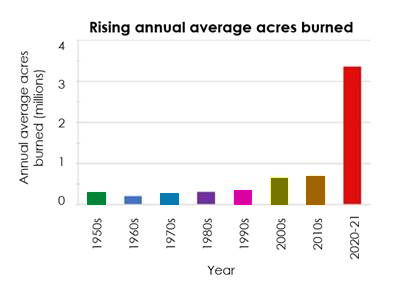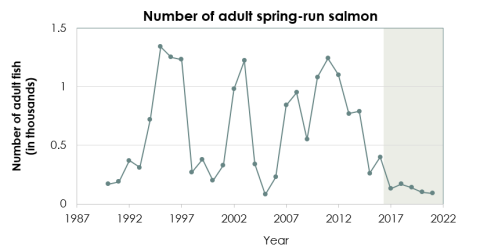
New report shows rapidly accelerating effects of climate change, demonstrates importance of state actions
Contacts
CalEPA: Erin Curtis, (916) 324-9670
OEHHA: Amy Gilson (916) 764-0955
For Immediate Release
Governor Newsom’s California Climate Commitment, other world-leading climate actions must continue to protect human health, the environment, and Tribes.
Report findings detail escalation of climate crisis – half of state’s largest wildfires in past 70 years occurred in just two years, the last two decades have been the driest in past millennium, California glaciers rapidly disappearing, and temperatures up 2.5 degrees since 1895.
SACRAMENTO – Ahead of the 2022 United Nations Climate Change Conference (COP27), California state scientists have released a new report that shows how the impacts of climate change are rapidly accelerating in California. Key findings illustrate an exponential increase in wildfires and point to a hotter, drier environment driven by megadrought. The report’s release follows a summer of record-breaking heat, during which the West Coast broke nearly 1,000 temperature records during a 10-day heat wave.
CalEPA’s Office of Environmental Health Hazard Assessment today released the fourth edition of its Indicators of Climate Change in California Report, documenting the wide-ranging impacts that global fossil fuel reliance has had on the state’s weather, water supplies, plants and animals, and human health, including Tribes.
This past summer, Governor Gavin Newsom signed a slate of aggressive climate measures that will accelerate California’s transition to a carbon-neutral economy while protecting people in California from pollution and holding companies responsible for their pollution. This package adds to the $54 billion California Climate Commitment, with more investments to protect people from the impacts of climate change and transition to clean energy and jobs. This plan will:
- Create 4 million new jobs
- Cut air pollution by 60%
- Reduce state oil consumption by 91%
- Save California $23 billion by avoiding the damages of pollution
- Reduce fossil fuel use in buildings and transportation by 92%
- Cut refinery pollution by 94%
“Across the state, we live the experience of extreme weather, deepening drought. and deadly wildfires and heatwaves,” said CalEPA Secretary Yana Garcia, “This report shows scientifically what we know from experience. It is why the Newsom Administration has enacted the nation’s most aggressive climate measures in history to cut pollution and move even faster to a clean energy economy that leaves no community behind.”
Since the last update in 2018, weather extremes have intensified and become more erratic. Some changes in the past four years are irreversible, such as the near disappearance of glaciers from the Trinity Alps. Six new indicators were added to this report, including three new human health indicators - occupational heat-related illness, valley fever and wildfire smoke.
Key findings of the report include:
- Extreme Heat and Health. Since 1895, annual average air temperatures have increased by about 2.5 degrees F statewide, creating hotter and drier conditions in California. Reports of work-related heat illness tripled in just the past 20 years.
- Wildfires and wildfire smoke. Half of the 20 largest wildfires in the past 70 years burned in just two years - 2020 and 2021.
- Drought. The years 2000-2021 were the driest 22-year period in the past millennium, part of an emerging “megadrought” era.
- Glacier Loss. California’s glaciers have melted dramatically over the past century, essentially disappearing in the Trinity Alps and decreasing by 75 percent, on average, in the Sierra Nevada.
- Salmon. In the Klamath region of Northern California, spring-run chinook salmon numbers in the Salmon River have flat-lined below 200 in the past five years.
The report follows 41 climate change indicators in California, 27 of which scientists have been tracking since 2009. These indicators tell a story of cascading causes and effects: how California is getting hotter and drier, and how more extreme weather is disrupting and changing the state’s physical and natural environment and people. OEHHA collaborated with over 100 scientific experts and 40 Tribes to develop the report.
New to the report this year is science from OEHHA’s collaboration with California Tribes, incorporating climate change knowledge and impacts on Tribal Nations, including first-hand accounts written by Tribal members. Eight Tribes provide accounts of their unique experiences and 40 Tribes participated in listening sessions to inform the report.
Their stories illustrate the value of Tribal knowledge acquired from centuries of interactions with the Earth that pre-date instrumental records.
“Tribal culture and health are tied to the land and the environment. California Tribes have acquired knowledge and developed management practices since time immemorial,” OEHHA Director Dr. Lauren Zeise said. “This report contributes to the scientific foundation for understanding how a warming planet impacts people and recognizes Tribal knowledge as a crucial part of that foundation.”
The full Indicators of Climate Change Report is complemented by an 18-page summary (Español), Story Map, and information about OEHHA’s Tribal engagement.
CalEPA is tracking how the state’s bold actions are measuring up to its goals for slowing the planet’s warming and adapting to a changed environment. The California Climate Dashboard shows how actions such as electric car and truck incentives and clean energy development have already led to tangible benefits like cleaner air, cleaner cars and affordable clean energy.
Scientists and Tribal representatives are available to speak to the media. Please email Amy Gilson to set up an interview.
OEHHA’s mission is to protect and enhance the health of Californians and our state’s environment through scientific evaluations that inform, support, and guide regulatory and other actions



